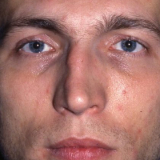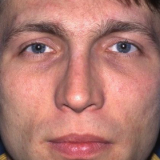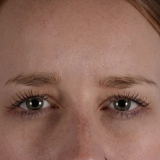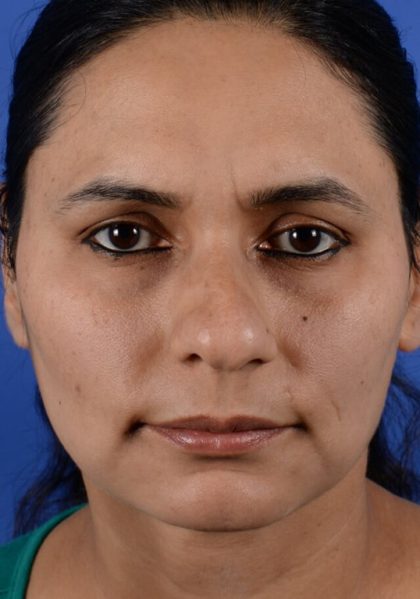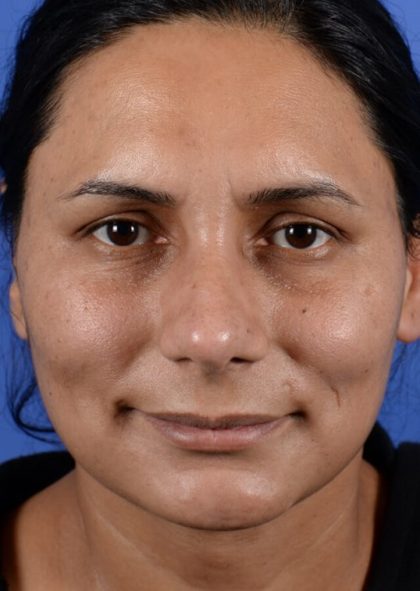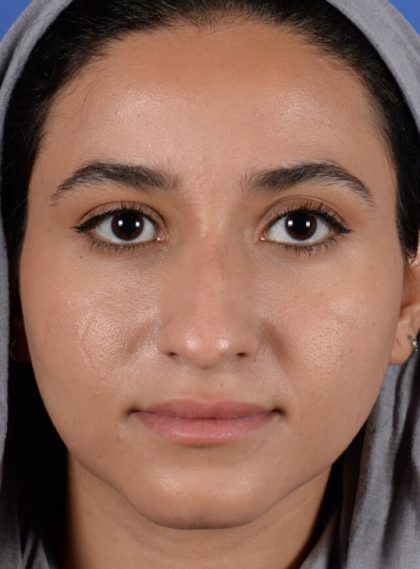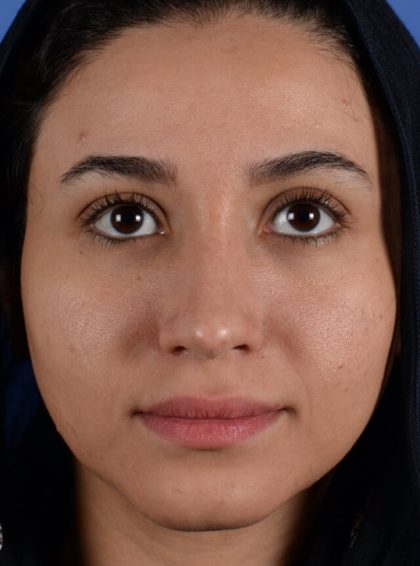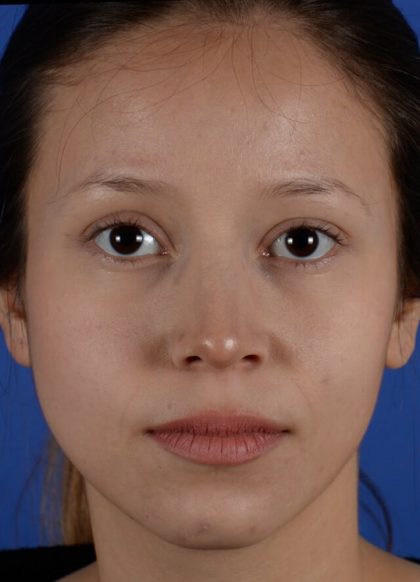Ethnic Rhinoplasty
Conveniently located to serve the areas of Englewood and Denver, CO

Ethnic rhinoplasty is a form of rhinoplasty where surgeons take significant consideration into preserving one’s ethnic characteristics. They typically perform this procedure via an open approach. This technique involves internal incisions as well as along the columella. This allows for complete exposure of the underlying cartilages and bony framework. Sometimes, surgeons reduce the nostrils which merits small incisions underneath the nose. Rib cartilage is often employed to allow for improved structure and definition.
Contents [hide]
Before and After Photos
About Rhinoplasty
In general, rhinoplasty involves making internal changes to the structure of the nose to create a more flattering aesthetic or improve functioning. Rhinoplasty is one of the oldest recorded procedures; research into nasal reconstruction began as far back as 1500 B.C. (1) Beginning in ancient times, surgeons have been able to find methods of correcting a variety of cosmetic issues including dorsal humps, an overly pointed or rounded nasal tip, crooked nose, over and undersized nostrils, and over or undersized nasal bridge. For functional purposes, rhinoplasty can serve to repair damaged tissue and abnormalities that affect air circulation. While there are a variety of techniques to create the necessary changes, high-quality surgeons also strive to work with each patient to find a nasal contour that is harmonious with the rest of the face. For rhinoplasty, there is no one-size-fits-all approach because everyone has unique facial features and ethnic backgrounds. Surgeons must be mindful of performing surgery in a way that promotes natural-looking results and enhances one’s existing beauty.
At Colorado Facial Plastic Surgery in Denver, our surgeons do not follow short-lasting beauty trends and ideals of the “perfect” nose. During a consultation, you will be able to voice your concerns and find a solution that honors your ethnic characteristics, improves any breathing dysfunctions you may have, and helps you feel like the most confident version of yourself. Candidates for an ethnic rhinoplasty include Asians, Latinos, African-Americans, and Middle Easterners- each with certain nasal features that distinguish one from another.
To learn more about our approaches to this variation of the rhinoplasty, call (303) 839-7980 or inquire with our online contact form, and a member of our practice will gladly schedule your consultation at a time most convenient for you.
Variations of the Ethnic Rhinoplasty
Asian Noses
Asian noses tend to be wide and under-projected with thick skin and low bridges on profile. (1) A common request is to raise the bridge, create more definition to the tip, and reduce the width of the nostrils. There is often only a small amount of septal cartilage, necessitating the discussion of needing to harvest rib cartilage. In our experience, rib is needed in 75% or more of cases requiring substantial change, and utilizing one’s own rib is preferred to donor cartilage. Because of the thick skin and weaker cartilage, surgeons must apply strong grafts to hold the nose in position. In these cases, it is important to avoid too much projection, narrowing, or bridge height which can make the nose appear too Caucasian in nature.
Latino Noses
These noses often present with moderate to significant humps on profile in addition to medium-thick skin and under-rotated as well as under-projected tips. (2) As a result, our surgeons often reduce the hump, increase projection and rotation, and define the tip. Septal cartilage is usually sufficient, though, ear cartilage may be needed. Again, overly-rotated and excessively-defined tips can be seen as unsightly.
African-American Noses
These noses can present with similar challenges as Asian noses. The skin is often thick, the tip is under-projected, poorly defined, and wide, and the nostrils are flared. (3) Patients often desire improvement in the bridge height, reduction in nostril width, and more definition to the tip. Septal cartilage tends to be limited in amount, and surgeons employ rib cartilage in most cases. Like with Asian noses, it is vital not to overly define and project the nose which can be interpreted as losing some of the mentioned ethnic features.
Middle-Eastern Noses
These noses can have thick skin with significant humps on profile and appear large, especially at the tip. In many males, the hump is a defining feature, and surgeons should strive to avoid full reduction. (4) The septal cartilage tends to be plentiful, so there is often no need for a cartilage graft. The goals often involve tip de-projection with increased rotation and a smaller tip size. As with other thicker-skinned ethnicities, surgeons may recommend a specialized skin care regimen and/or steroid injections to help maintain definition long-term.
Regardless of ethnicity, a thorough conversation during the consultation is a must to ensure that patients clearly understand the endpoints of surgery. By understanding the inherent anatomy of each ethnic group, the surgeons at Colorado Facial Plastic Surgery can aid in preserving certain defining features while improving others.
Personal Consultation
The initial consultation is critical for the surgeon to understand patient expectations and any information regarding prior surgeries. Although some surgeons review old medical and operative reports, this is not always needed, useful, or available. Many patients can reiterate the original reason for surgery, the timeframes, and the postoperative course. Some patients even provide pre-operative photos which can be helpful. Physical examination assists with visualizing old scars, any functional deficits, and undesired changes. The clues that the surgeons gain in this examination can give insight into how any prior surgeries might have been performed (i.e. scar on columella would indicate an open approach).
Photography is crucial to be able to objectively evaluate the structure of the nose. The “fun” part of the consultation is reviewing the patient’s photographs and subsequent morphing. The surgeons utilize one of two programs that accomplish similar goals – Uniplast® by United Imaging or Mirror® by Canfield Scientific, Inc. These programs allow the surgeon to move portions of the image to make changes based on the patient’s desires. This allows the patient to see what may be possible with surgery. These photos, though, do NOT represent a guarantee of outcome. The surgeon will use these photos in surgery as a goal and reminder during the surgery itself.
With knowledge of the prior procedures, current photographs, and desired goals, the surgeon can formulate a plan concurrently with the patient.
Preparation
A pre-operative visit will typically occur 1 to 2 weeks before your surgery. During this time, you will meet with our nurse who will review – in detail – all day-of-surgery and post-operative instructions. This will include reviewing medications to take before and/or after surgery, phone numbers for any post-operative issues, and wound care. The patient will also meet with the surgeon to finalize all plans for the procedure. This may include reviewing goals for the operation and morphed photos.
Procedure
The procedure occurs at a hospital or surgery center under general anesthesia. Depending on the extent of the procedure, it can last anywhere from 3 to 7 hours. Your surgeon will discharge you home after scheduling a follow-up in-clinic appointment one week later.
Recovery
The first follow-up visit occurs within 1 week after the procedure. At that visit, the surgeon will remove your cast, tape, splints, and sutures. They will clean and evaluate your wounds to determine your healing progress. They will emphasize the importance of wound care instructions and follow-up visits throughout the recovery process. Aside from walking, you should restrict vigorous exercise for at least 3 to 4 weeks post-surgery. Pain is often mild for the first few days and manageable with medications. If you have a rib cartilage graft, it is imperative that you follow instructions regarding deep breathing and walking to assist with recovery. A low-salt diet with plenty of fluids will help to reduce swelling. You should not blow your nose until you have received clearance by your surgeon.
Results
The nose will appear quite swollen upon cast removal, but this is in no way representative of the outcome. Those with thicker skin will often need more time to show a result. (5)(6) We cannot stress enough the importance of follow-up visits to ensure the best possible result and patience during the healing process. If any asymmetries occur that may need to be addressed, we often wait 10 to 12 months to ensure swelling has minimized significantly before proceeding.
Cost of Ethnic Rhinoplasty in Denver
Ethnic rhinoplasty pricing can vary depending on the complexity of the case. Surgeon’s fees can range anywhere from $6500 to over $10,000. Please remember that these numbers do not include the cost of the facility and anesthesia. Still, we strive to provide you with high-quality care that is sensitive to your financial needs. During your consultation, your surgeon will give you a comprehensive summary of all costs involved and review our practice’s financing options with CareCredit and Prosper.
To get started today, call our Denver office at (303) 839-7980, or request your consultation online. If you are interested in learning more about our other available services and minimally invasive procedures, feel free to visit our blog. Regardless of your chosen procedure, our staff and surgeons promote a welcoming, positive environment for you to feel comfortable addressing your concerns. We look forward to helping you achieve transformative results with ethnic rhinoplasty.
FAQ
Who is an ideal candidate for ethnic rhinoplasty?
Individuals with mixed-race and non-white features will benefit from the customized approach of ethnic rhinoplasty. Ideally, candidates should be non-smokers and in good general health.
How is the ethnic rhinoplasty different?
Ethnic rhinoplasty techniques take into account individuals’ unique ethnic features of the nose and face as a whole. Different ethnicities have differently shaped cartilage structures within the nose, so surgeons must custom-tailor their techniques. Surgeons can create attractive, functional results that do not look unnatural in relation to the rest of the face.
Will I have scars from an ethnic rhinoplasty?
You will only have one discreet scar line along the columella, the portion of tissue that separates the opening of the nostrils. After some time, this scar will fade considerably and be hardly noticeable.
References
- Toriumi DM, Pero CD. Asian rhinoplasty. Clin Plast Surg. 2010 Apr;37(2):335-52. doi: 10.1016/j.cps.2009.12.008. PMID: 20206750.
- Cobo R. Rhinoplasty in Latino Patients. Clin Plast Surg. 2016 Jan;43(1):237-54. doi: 10.1016/j.cps.2015.09.003. PMID: 26616711.
- Boahene KDO. The African Rhinoplasty. Facial Plast Surg. 2020 Feb;36(1):46-52. doi: 10.1055/s-0040-1701628. Epub 2020 Mar 19. PMID: 32191958.
- Azizzadeh B, Mashkevich G. Middle Eastern rhinoplasty. Facial Plast Surg Clin North Am. 2010 Feb;18(1):201-6. doi: 10.1016/j.fsc.2009.11.013. PMID: 20206101.
- Toriumi DM. Structure approach in rhinoplasty. Facial Plast Surg Clin North Am. 2005 Feb;13(1):93-113. doi: 10.1016/j.fsc.2004.07.004. PMID: 15519931.
- Shaye DA. The history of nasal reconstruction. Current Opinion in Otolaryngology & Head & Neck Surgery. 2021;29(4):259-264. doi:https://doi.org/10.1097/moo.0000000000000730
- Toriumi DM, Kowalczyk DM, Cristel RT, Caniglia AJ, Curran N, Lombard R, Kerolus JL. Evaluation of Postoperative Infection Rates in 3084 Rhinoplasty Cases Using Antibiotic Soaks and/or Irrigations. Facial Plast Surg Aesthet Med. 2021 Sep;23(5):368-374. doi: 10.1089/fpsam.2020.0465. Epub 2021 Apr 5. PMID: 33798400.


